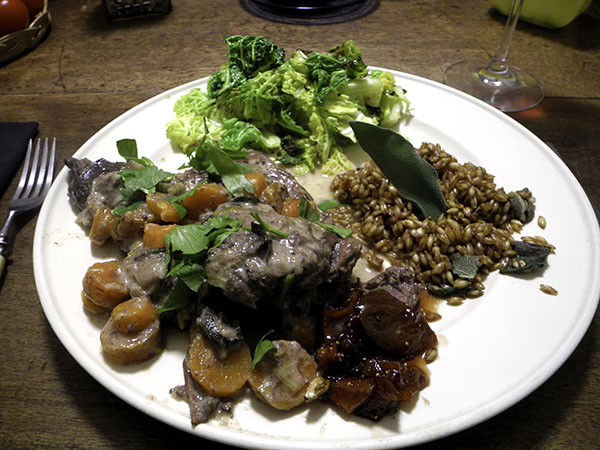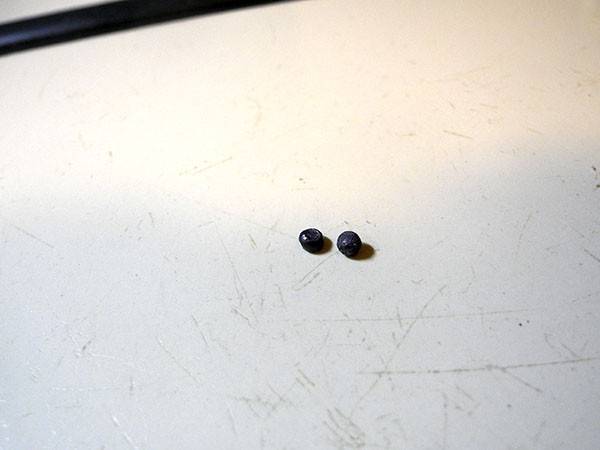
One Scottish hare.
It turned out to be a 2-day feast, not necessarily because there was so much meat, but mostly because I was anxious to try to specifically prepare ‘saddle of hare’ (the phrase had always attracted me, like ‘haunch of venison’). For the saddle, see the next day’s post.
But there definitely was enough protein for 2 meals, since this really is probably the richest, gamiest traditional European-tradition game of all: A little hare goes a long way.
It’s not rabbit.

Our lepus europaeus was brought down in the field, with a shotgun, although not by the cook. While it was here we discovered two clues for identifying the manner of its demise, one while preparing the hare, one while enjoying it on the plate.
I bagged it myself only after spotting it behind the glass-door of Ottomanelli’s freezer the afternoon I picked up a large Kassler roast I had ordered for New Years Day. The price of the hare was surprisingly reasonable, especially considering how far it had flown to get here. I couldn’t resist bringing it home, even knowing it would steal a good chunk of the less-than-vast interior of our apartment refrigerator for much of a week while it lay inside, defrosting, then waiting for the cook’s attentions.
- one Scottish mountain hare (2.6 lbs) purchased frozen from Ottomanelli’s on Bleecker Street in the West Village, defrosted over several days, cut into 10 pieces, including 4 sections from the saddle, which were later to be reserved later for a second meal, placed inside a large bowl in a marinade composed of one sliced ‘Expression Sweet’ yellow onion and 3 small carrots, also sliced, both from Norwich Meadows Farm; several small stems of celery from Phillips Farms, cut into small pieces; 4 cloves of Krasnodar red garlic from Quarton Farm; 7 large sage leaves from Whole Foods Market; 8 peppercorns; and one half bottle of wine (F. Stephen Millier Symphony), all left inside the refrigerator overnight, turning a few times before preparing the dinner the next evening, when the meat was removed from the marinade and dried, the wine and the vegetables strained and reserved separately, a tablespoon of olive oil heated inside a heavy enameled cast iron dutch oven, the vegetables tossed in and sautéed until translucent, then the hare browned over high heat inside another pan, a seasoned steel skillet, in roughly a tablespoon of butter, after which it was deglazed with about a tablespoon of Courvoisier V.S. cognac, the meat and the juices transferred to the dutch oven with the vegetables, where everything was seasoned with sea salt and one cup of the wine marinade poured in, followed by enough good chicken stock to partially cover the hare, cooked over a moderate flame for about an hour and 15 minutes, stirring occasionally, when another tablespoon of cognac was added, plus about 2/3rds of a cup of light cream, the liquid allowed to thicken, while stirring some, hare and vegetables arranged on the plates, ladled with the sauce and finished with chopped lovage from Two Guys from Woodbridge
- a rich chutney remaining from dinner on New Years Day, whose ingredients and preparation are described in this post
- three fourths of a cup of ‘Buck Berries, Naked Winter Barley’ from the [Union Square] Greenmarket’s Original Grains Project, cooked a bit like a risotto, with 2 and a quarter cups of water, stirring occasionally until thickened, or roughly 40 minutes (I didn’t actually time myself), seasoned with salt and butter, 6 large sage leaves, a bit of crushed home-dried habanada pepper, a couple tablespoons of butter added and stirred in off heat at the end [Cook’s note: next time I think I’ll try preparing it more like I do risotto, starting with the fat, heating the grain in it, them adding the liquid, which can vary]
- one small Savoy cabbage from Norwich Meadows Farm, washed, quartered, cored, sliced into one-half-inch ribbons, sautéed in a scant tablespoon of olive oil inside a large heavy, tin-lined copper pot until wilted but still a little crunchy, stirring occasionally, seasoned with sea salt and freshly-ground black pepper, 8 or so slightly smashed juniper berries then mixed in, a few drops of balsamic vinegar added and stirred over the heat for only a moment, the cabbage arranged on the plates and finished with a drizzle of olive oil
- the wine was a very special Italian (Piedmont) red, Cascina Chicco, Barolo ‘Rocche del Castelletto’ 2013, from Flatiron Wines
- the music was Mozart’s 1786 opera buffa, ‘Le nozze di Figaro’, Yannick Nézet-Séguin conducting the Chamber Orchestra of Europe and the Vocalensemble Rastatt, with soloists Luca Pisaroni, Christiane Karg, Sonya Yoncheva, Thomas Hampson, Angela Brower, Anne Sofie von Otter, Maurizio Muraro, and Rolando Villazón Mauleón